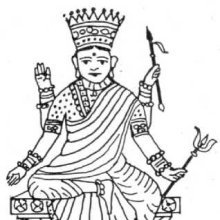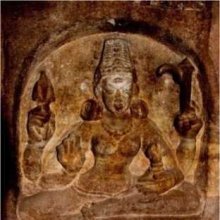Ajitabala, Ajitabalā, Ajita-bala: 9 definitions
Introduction:
Ajitabala means something in Buddhism, Pali, Jainism, Prakrit, Hinduism, Sanskrit. If you want to know the exact meaning, history, etymology or English translation of this term then check out the descriptions on this page. Add your comment or reference to a book if you want to contribute to this summary article.
Images (photo gallery)
In Buddhism
Mahayana (major branch of Buddhism)
Source: Wisdom Library: LokottaravādaAjitabala (अजितबल) is the name of a Buddha under whom Śākyamuni (or Gautama, ‘the historical Buddha’) acquired merit along the first through nine bhūmis, according to the Mahāvastu. There are in total ten bhūmis representing the ten stages of the Bodhisattva’s path towards enlightenment.
Ajitabala is but one among the 500 Buddhas enumerated in the Mahāvastu during a conversation between Mahākātyāyana and Mahākāśyapa, both principle disciples of Gautama Buddha. The Mahāvastu is an important text of the Lokottaravāda school of buddhism, dating from the 2nd century BCE.

Mahayana (महायान, mahāyāna) is a major branch of Buddhism focusing on the path of a Bodhisattva (spiritual aspirants/ enlightened beings). Extant literature is vast and primarely composed in the Sanskrit language. There are many sūtras of which some of the earliest are the various Prajñāpāramitā sūtras.
In Jainism
General definition (in Jainism)
Source: archive.org: The Jaina IconographyAjitabalā (अजितबला) or Ajitā or Rohiṇī is the name of the Yakṣiṇī accompanying Ajitanātha: the second of twenty-four Tīrthaṃkaras or Jinas, commonly depicted in Jaina iconography.—The Jaina original books give him the symbol of elephant (Gaja) and his other symbol, namely his special tree (kevalavṛkṣa) tree both being connected with his images. Further, two other iconographic points by which Ajitanātha’s statues may be differentiated from those of others are the figures of his particular Yakṣa called Mahāyakṣa and his Yakṣiṇī named Ajitabalā. Mention of these is made in the Jaina canonical Literature. His posture is what is technically known as khaḍgāsana i.e., standing with two arms hanging on the sides. His chowrie-bearer is Sagaracakrī.
Source: archive.org: TrisastisalakapurusacaritraAjitabalā (अजितबला) is the name of a Yakṣiṇī (i.e., Śāsanadevatā) associated with Ajita, according to chapter 2.3 [ajitanātha-caritra] of Hemacandra’s 11th century Triṣaṣṭiśalākāpuruṣacaritra: an ancient Sanskrit epic poem narrating the history and legends of sixty-three illustrious persons in Jainism.
Accordingly:—“[...] Then arose the divinity Ajitabalā, gold-color, shining with two right hands, one in varada-position and one holding a noose; adorned with two left hands holding a citron and a goad, standing on an iron seat, she was a messenger-deity at the Lord’s side”.

Jainism is an Indian religion of Dharma whose doctrine revolves around harmlessness (ahimsa) towards every living being. The two major branches (Digambara and Svetambara) of Jainism stimulate self-control (or, shramana, ‘self-reliance’) and spiritual development through a path of peace for the soul to progess to the ultimate goal.
Languages of India and abroad
Sanskrit dictionary
Source: DDSA: The practical Sanskrit-English dictionaryAjitabalā (अजितबला).—Name of a Jain deity who acts under orders from the Arhat Ajita.
Ajitabalā is a Sanskrit compound consisting of the terms ajita and balā (बला).
Source: Cologne Digital Sanskrit Dictionaries: Edgerton Buddhist Hybrid Sanskrit DictionaryAjitabala (अजितबल).—name of a former Buddha: Mahāvastu i.140.2.
Source: Cologne Digital Sanskrit Dictionaries: Monier-Williams Sanskrit-English DictionaryAjitabalā (अजितबला):—[=a-jita-balā] [from a-jita] f. Name of a Jaina deity who acts under the direction of the Arhat Ajita.
Source: Cologne Digital Sanskrit Dictionaries: Goldstücker Sanskrit-English DictionaryAjitabalā (अजितबला):—[bahuvrihi compound] f.
(-lā) The name of one of the Śāsana-devatās, a class of divinities particular to the Jainas, who are supposed to carry out the commands of the Arhats. E. ajita and bala.
[Sanskrit to German]
Sanskrit, also spelled संस्कृतम् (saṃskṛtam), is an ancient language of India commonly seen as the grandmother of the Indo-European language family (even English!). Closely allied with Prakrit and Pali, Sanskrit is more exhaustive in both grammar and terms and has the most extensive collection of literature in the world, greatly surpassing its sister-languages Greek and Latin.
See also (Relevant definitions)
Full-text: Rohini, Sagaracakri, Ajita, Mahayaksha, Ajitanatha.
Relevant text
Search found 4 books and stories containing Ajitabala, Ajitabalā, Ajita-bala, Ajita-balā; (plurals include: Ajitabalas, Ajitabalās, balas, balās). You can also click to the full overview containing English textual excerpts. Below are direct links for the most relevant articles:
Trishashti Shalaka Purusha Caritra (by Helen M. Johnson)
Part 34: Ajita’s Śāsanadevatās < [Chapter III - The initiation and omniscience of Ajita]
The Mahavastu (great story) (by J. J. Jones)
Chapter XVI - The ninth Bhūmi < [Volume I]
Jainism in Odisha (Orissa) (by Ashis Ranjan Sahoo)
Maa Bhagavati Temple < [Chapter 3: Survey of Jaina Antiquities in Odisha]
Jaina Remains at Jamunda Village < [Chapter 3: Survey of Jaina Antiquities in Odisha]
Jaina images of Bhairava Singhpur at Jeypore District Museum < [Chapter 3: Survey of Jaina Antiquities in Odisha]
Jain Remains of Ancient Bengal (by Shubha Majumder)

